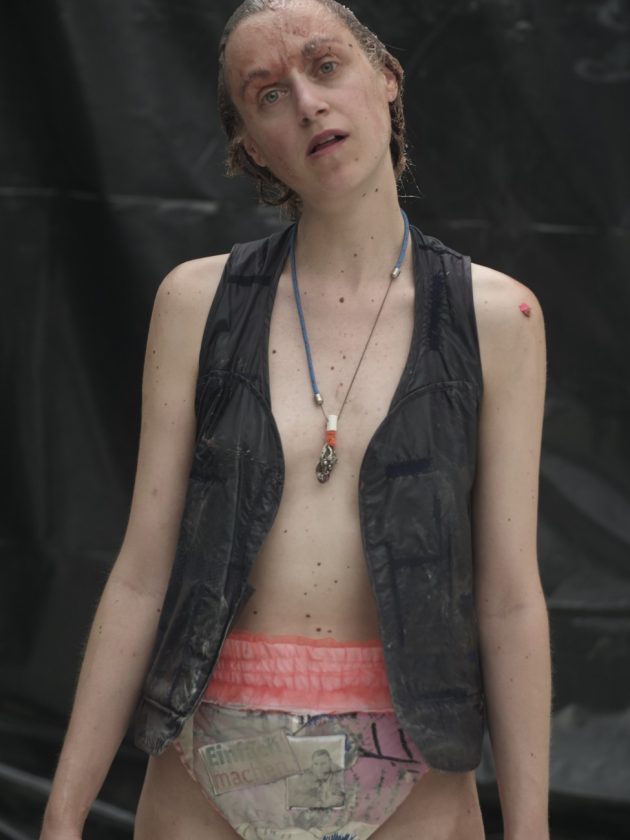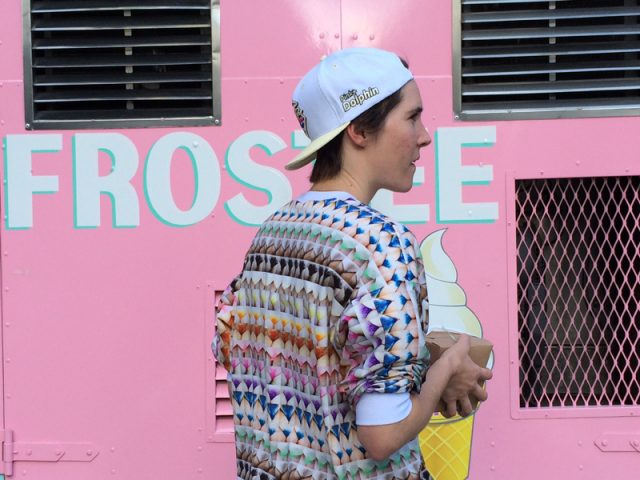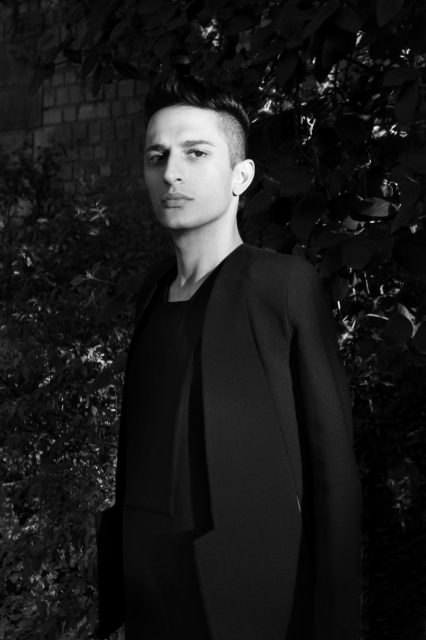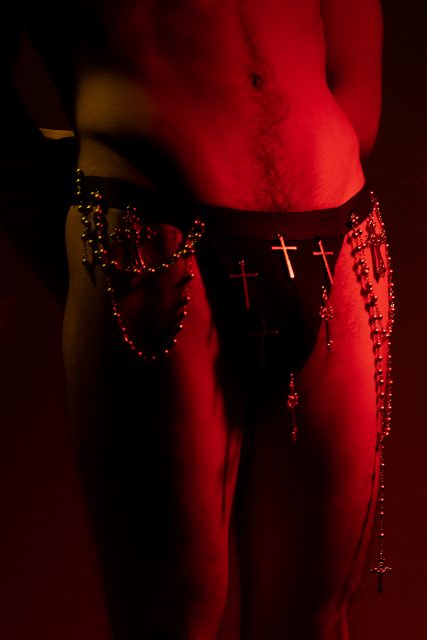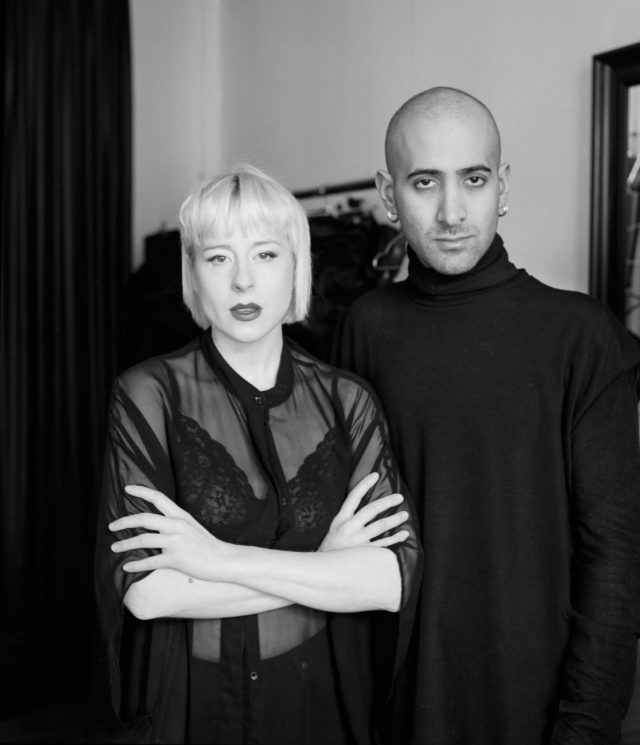Transformation, Process, Counterego. Anyone who talks with Susi Hinz quickly dives into the depths of concept and understands: these discussions are part of the Berliner’s versatile practice, which cannot be categorized simply as fashion design or visual art. Interviewer Agnesa Schmudke met Susi after her performance „HEADMACHINE: Ego im Gegenego“ (“Ego in the Counterego”), which she presented at the exhibition „unlucid“ in the greenhouses in Berlin-Dahlem in July. As part of Kleine Humboldt Galerie’s exhibition festival „unselect“, she showed wearable sculptures, drawings, paintings, a sound collage and even participated as a performer. A conversation about clothing, limiting attributions and the infinity of the universe.
Agnesa: When I was in your studio for the first time, you showed me your collections. There were small treasures on your shelves, things you found, collected and then arranged. Even your walls were filled with drawings and written sketches, which were divided into categories. What does collecting mean to you?
Susi: Gathering is like a historiography from which I learn a lot about myself. I collect things because they trigger something in me, they catch my eye – then I cannot help but take them with me. It also has something to do with wanting to own, which I was initially critical of. But then I realized that it had something to do with my creative process. If a thing can already touch you because you perceive it, it does not happen just like that. I want to give it a run, take the thing into the story that opens up. How I combine my finds later is just a matter of feeling. It’s an excitement that feels right and then I release it.
Agnesa: That reminds me of the wearable sculptures you create, where you combine fabrics and objects in very unusual ways.
Susi: Yes, that’s quite similar. I do not plan or control these processes; it is rather an emotion that feels right. An energy that, when you are able to perceive it, tells you how things belong together, what they do to you and how they move you. You feel if something is really shit and you just force it. The only question is: How open are you to deal with these feelings? Are you deceiving yourself because you think others will find it cool, or are you really open to what feels right to you?
Agnesa: What does clothing mean to you?
Susi: For me, clothing is like a drawing, except that it is not on the wall but on human bodies. People – with the addition of their expression, identity, and inner life – create something new, bring the drawing into the three-dimensional space and in context with the body. That’s what distinguishes drawing from fashion – at least the way I create and understand the term. It does not hang on the wall but interacts with the people who wear it.
Agnesa: This brings me back to the question of feeling. Thinking about preparations for your performance HEADMACHINE: Ego im Gegenego, which you organized in the greenhouses in Dahlem for the exhibition festival „unselect“, you were looking for very special characters to present your designs. Is your decision for the people who wear and present your work based on feelings as well or do you have certain figures in mind while creating the pieces?
Susi: This is not the crucial point in my process, I think. If I don’t call myself fashion designer in the primary sense, it’s because I don’t design for people. For the works that were shown in the performance, drawings were the basis. I wanted to translate them into the three-dimensional space, and because these drawings had something to link them to humans, the idea came up to using them as clothing instead of building them from wood or perspex. These choices may vary. I do not only design but make conceptual decisions. If it is necessary to bring designs and the human body together, then wearable sculptures can be the result. For the performance HEADMACHINE: Ego im Gegenego I looked for people who radiated something forward-looking. Who expressed them being in a process of transformation, to be creating, to be curious, to be open and to dare. People who are not afraid to try something that is not yet mainstream or cool.
Agnesa: Was not transformation also one of the concepts that used to hang on your studio wall?
Susi: Exactly. There were even more terms, such as autonomy, rhythm or writing. These were the umbrella terms. But I am also interested in processes such as erosion, crystallization and melting. When thinking about the idea of transformation, which already concerned me throughout my studies, I often criticized that in fashion I could only work on the surface. With the second skin, so to speak. Now it is important for me to work into the substance and from within it. And that’s why I wanted to explore such key concepts and see how they evolve out of me. It was not planned to work with these terms. But by choosing my materials, such as honey, vaseline, and beeswax, I had to necessarily deal with their properties and examine them.
Agnesa: When you think back to your studies in Berlin, which you completed two years ago, how did that time shape you? Were there any things that annoyed you in fashion design?
Susi: What annoyed me not only throughout my studies, but also in other fashion contexts, was the question: “Who should wear this?” And “Who should buy it?” Or “What does this cost?” Or “Could you even produce this in mass?” Once, for example, I created an outfit out of wood and leather, fabrics from renewable resources. But then people immediately asked: “Who is supposed to wear this?” And that annoyed me very much. Or the question of who I actually was, fashion designer or artist, and how, in this respect, I wanted to earn money.
For me, fashion has so much potential that allows it to reinvent itself over and over again. But therein lies its decay – in its fast pace. As a result, fashion does not have the opportunity to go into depth and thus into compression. It consumes itself and lives off wasting itself and others. The fashion industry is exhausting resources to be “new” again and again and faster. Fashion has no time. Every time I realize that, I decide that this is not my path.
Agnesa: You already worked with wood and leather during your studies, today you are dealing with honeycombs and vaseline. What other materials have accompanied you and your practice?
Susi: Throughout my studies, I was interested in materials that create plasticity. Forms and colors were very exciting to me as well as materials that could create sculptural structures. That’s why I worked with neoprene in my first semester. It allows you to create very sculptural and organic forms and to work very instinctively. And then I tried out wood and leather – as part of a project about Hieronymus Bosch. At that time, we were working on the subject of historical costumes. I had chosen his tryptic The Garden of Earthly Delights and created designs digitally which I later transformed into wood, leather and foamed material. In this way, I brought the materials into the present – foam is just omnipresent today, but often also hidden, because it is covered with a second skin. It has many qualities that can be sculpted, but it is also highly toxic and harmful. That, for me, suited Bosch’s The Garden of Earthly Delights as well as the subject of sin, that I was particularly interested in. Later I focused on foam and transformed it by melting processes or coating. In my final thesis I played very virtuoso with different materials and techniques.
Agnesa: In The Garden of Earthly Delights, there are these hybrid creatures, fantasy figures that seem to have sprung from a fever dream. They become one with their absurd costumes. To what extent does this happen in your work? That the people wearing your designs become one with them. Your designs, on the one hand, resemble suits of armors, that make the individuals wearing them disappear, on the other hand you play with the translucent properties of your fabrics.
… suddenly a gust of wind and the noted questions fly into the Spree
Susi: Yes! That’s awesome! The questions in the water, that’s how it has to be.
Agnesa: Okay, now the questions are in the Spree.
Susi: Transformation!
Agnesa: Like a capsule for the future, now they’re swimming somewhere, maybe they’ll turn up at a place on the shore …
Susi: Be water my friend.
Agnesa: Go with the flow. Now, we just do that and keep going. We stopped at the idea of the armor. The question is to what extent your works are also shells or covers.
Susi: I think it’s true that I create covers in my work, or cocoons, so to speak. I think people accept that automatically, like a protection zone. And by doing that with a feeling … I mean, I just mean it honestly. To create this protection zone where you can feel new forces and rediscover yourself. What interested me in the performance „HEADMACHINE: Ego im Gegenego“ is not only to solely show „HEADMACHINE“, which was my final thesis at art school, but also to make visible the processes that interest me today. For example, the ideas that were established by Rudolf Steiner: thinking, feeling, willing as the key points of the social threefolding. „HEADMACHINE“, that’s exactly what it means: a machine ruled by the head. Here, in an instinctive, childlike way, I wanted to explore what occupied me internally and to reflect that rationally. The connection of thinking, feeling and willing is important, after all, I cannot only think that something is cool, I also have to feel and implement it.
I am also interested in images and counter-images. When I compare this with clothing as a three-dimensional drawing in space, it means that there is an ego and a counterego. We all have an ego, but how would it look if we took a bird’s-eye view of what we were doing and what the opposite could be – is that not an ego again? That’s how it turned out: to my older works, which were very colorful and consisted almost exclusively of plastic materials, I started adding the counterparts with honey, honeycombs, vaseline and pigments on wood and on the body. Materials that can be transformed differently and which produce other ideas and questions. These materials represent the state X of chaos, everything is possible, and everything is uncertain.
Agnesa: Questioning the importance of such materials, in particular fat, with its processes of solidification and melting strongly reminiscent of Joseph Beuys. Are there other inspirations? Where do you like looking?
Susi: I feel strong gratitude when I look into the universe at night. That’s something that touches me. This looking means to feel, to sense and to internalize that we are so incredibly small. And we also do not know what’s out there. This gives me gratitude and the certainty of saying that the course of events is good as it is. That’s the biggest source of inspiration and everything else just happens. If you say Beuys – I have never dealt with Beuys until I found this book of him. It just appeared one day in my street, leaning against a house wall. The universe gives me confidence that it’s okay that I do not know anything and that everything is possible. At the same time, there is always a lot of tension in the question of whether I’m a fashion designer or an artist. I’m not a fashion designer, but I’m not an artist either. It’s a life’s work! And that’s why I made the diaper piece, with the image of Joseph Beuys on the front and a picture of Jesus on the back. Everybody needs a protection Pampers today! These two people are key figures to me because they sacrificed themselves in some way, which is a great motivation to keep going. Their energies tell me: Take care of things and do not take yourself too seriously. And: don’t force yourself into categories.
Agnesa: Does that only happen when other people say that about you? When they introduce you primarily as a fashion designer, for example? I think that’s because we’re so used to attributing roles to people. That people eventually want to specialize because they believe that they can better profit from their expertise if they do so. This supposedly enables them to participate in the capitalist system. I think many people just give up living their versatility and their many processes. And that’s the reason why it’s so great when people can maintain that characteristic, discover things with a childlike enthusiasm and know that they do not need to embed themselves into some stupid systems.
Susi: Yes! At the same time, process and inspiration do not always mean fun and gratitude, they can also mean hard work, which can hurt. This has something to do with fear that you become aware of. Fear was also one of the concepts on my wall in the studio. Of course, suffering is part of everything, you have to get through it. Maybe that’s why it needs something like what you call armor. It’s because you go into some kind of war when you face your fears and suffer to heal the wounds. Who is the enemy? I and I?
Agnesa: To every meeting we had during the preparation for the exhibition festival, you were 15 minutes early and I was 15 minutes late. How important is precision to you?
Susi: Well, you have to realize what it’s all about. If you say precision, then you mean compression? In my sound collage on the performance at the exhibition „unlucid“ in the greenhouses in Dahlem I negotiated this term. Precision, concentration, focusing, compression. That’s just vital. We live in a time that is so strongly distracted … precision and condensation are therefore fundamental to me. At the same time, it is very important to open everything, to be chaotic and not to specify in advance, because then you give away the potential of creativity, of imagination and inspiration.
Agnesa: Your work in the greenhouses in Berlin-Dahlem consisted not only of a performance with wearable sculptures and the sound installation you mentioned, you also showed drawings and paintings and were even active as a performer. In all your work, Susi Hinz is recognizable, all the pieces seem to be part of a process. Nevertheless, after the show someone advised you to not go further into painting. How do you handle such feedback?
Susi: At first, I felt a great gratitude that someone criticized my work. By criticized I mean, that a person, previously unknown to me, told me something to think about and to empathize with. That does not happen so often. People quickly say “cool”, but you realize it’s just that. And then I saw for myself, I’m not a “painter”. And the works that were identified there as paintings are sketches for me.
Agnesa: On the other hand, I think about your work as developments, as processes towards something. I see experiences or experiments which happen in very different ways and don’t think people do you justice when they take those processes apart and say “this is painting now, so you should stop”. Your works all belong together. And that’s also one of your criticisms towards the fashion industry, that it only deals with what attracts people and does not ask what it actually means that we wear clothes, what information we generate by it, or how it changes us.
I also wanted to ask you how you deal with defeat. But now that we talked so much about processes, I think the term doesn’t quite fit anymore. When you talk about defeat, then something comes to an end. Something lies down, it dies?
Susi: You know, a year and a half ago, I lived in a forest for a month. Water was a big topic there, also the horizon. That’s when the thought came to me: where a vanishing point is, the perspective lines grow closer towards the rear. I see this thought represented by an “X”. If you look at it (crosses her index fingers to form an X), you have two triangles. Where they intersect, they also have the potential to reopen. A defeat for me is exactly the center of this X: You have a concentration on one point, a point of escalation, but if you manage to gather all your forces to focus and transform, then it opens again. Otherwise, you have a dead point there, but even then: if something dies, you can open it again. Energy and power are needed to turn things around and say, yes, it’s a defeat, but it goes on. Die Kugel rollt (the ball keeps rolling) … look, your questions are in the water.
Agnesa: Yes, they are in the water. Who knows where they are now? The thoughts on the paper will definitely dissolve and become one with the mud of the river. Or they will eventually end up in our drinking water. Where were we?
Susi: We were talking about defeats. And fashion and art. But honestly, someone who takes their job seriously, who recognizes their abilities and acts honestly, that’s art. This can be fashion art, butcher art or baker art. Fashion is just such a key element in my work because it’s so close to the body and the ego, because it communicates, it protects and because it just adorns us. There is an incredible potential for me in fashion to play with it, the body, the forms and colors, with spaces, with substances and then with the egos, without fear. Yes, to play without fear. Just keep going. Because every day counts.
 |
*Article and interview by Agnesa Schmudke
Agnesa is a Berlin-based art historian and curator, interested in image history and visual anthropology. Susi and she became close friends while collaborating as curators on the exhibition festival “unselect” by the collective Kleine Humboldt Galerie and have been sharing ideas over glasses of white wine ever since.
Links
Exhibition “unlucid” 13.07.2019 during exhibition festival “unselect” of Kleine Humboldt Galerie Berlin
Performer
Chiemi Miura
Annette Kasper
Film
Directed by Susi Hinz
Camera and photos by Jonny Brooking
Editing by Jonny Brooking + Susi Hinz
Soundcollage by Susi Hinz
Relating to the exhibition „unlucid“ special thanks to Sigrun Witt und Prof. Dr. Uwe Schmidt from Gewächshaus Dahlem, Polina Kokotov, Liz Stumpf, Theresa Kretsch, Jonny Brooking, Kleine Humboldt Galerie, Rektorin Weißensee Kunsthochschule Berlin Leonie Baumann and Mart Stam Gesellschaft.




